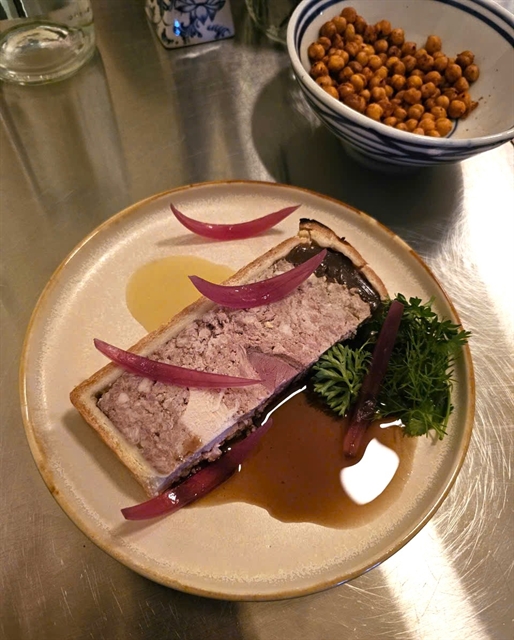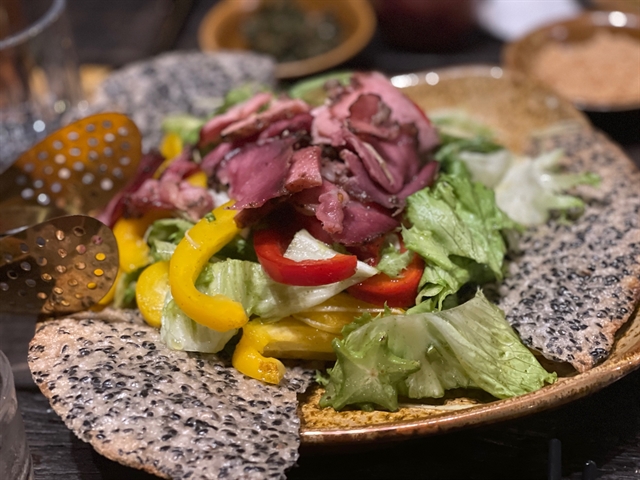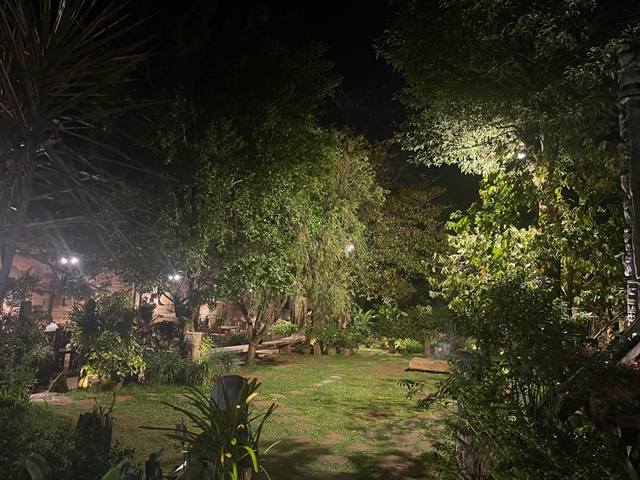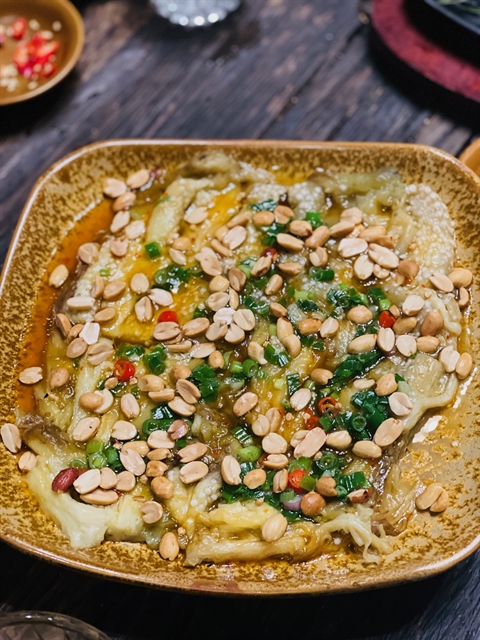 Restaurant Review
Restaurant Review

 |
| 'Gỏi nhà Arul', a mix of crispy lettuce and sliced red, yellow capsicum topped with smoked pork. VNS Photos Khánh Chi |
Nguyễn Khánh Chi
Near the centre of Buôn Ma Thuột City in Đắk Lắk, a Highlands province blessed with sun and wind, lies "Arul House" owned by H'len Niê—an Ê Đê woman deeply rooted in her ethnic culture and devoted to preserving the traditional values that are gradually fading in today’s fast-paced world.
H'len has refurbished her family's traditional longhouse on stilts and turned it and the surrounding land into a vibrant tourist attraction, called Arul House, filled with the cultural essence of the Ê Đê.
I arrived at Arul House expecting just a meal—a brief refuelling stop after a long working day during a business trip to the Central Highlands. But the moment I crossed the threshold, greeted by the longhouse-inspired architecture and the warmth of the welcome, I realised I was in for something far more special.
A touch of culture
Taking a moment to observe the details, it became clear that this was more than a restaurant—it was a cultural journey. Arul House, located in Akô Dhông Village in Tân Lợi Ward, is constructed entirely with wood, offering visitors a fully immersive experience of Central Highlands architecture, culture and landscape.
As we entered the gate and walked toward the rear garden, two traditional longhouses stood facing one another. Surrounded by native trees, flowering plants, and rustic wooden furniture, this enchanting setting was where our dinner would take place. The simplicity of the space, paired with its natural charm, exemplified the harmony between architecture and the environment.
.jpg) |
| A carved wooden statue features a pregnant woman. |
While waiting to be seated, I noticed a long wooden bench. Phương, one of the managers, later introduced it as a "kpan", an ethnic Ê Đê bench carved from a single tree trunk, typically 10–15 metres in length with slightly curved ends. Once a symbol of power, it was traditionally owned by wealthy families with exceptionally long houses and often used during festivals for gong and drum ensembles.
Inside the longhouse, our group of 20 sat directly on the wooden floor. The dining tables, made of thick panels of wood with spiderweb-like cracks, evoked the majesty of the surrounding forests.
 |
| The garden at the rear of Arul House with a 'kpan' - a traditional bench of the Ê Đê people. |
Gateway to local flavours
At Arul House, every meal is an invitation to explore the culinary and cultural heritage of the Central Highlands.
We began with a refreshing fermented passion fruit drink, served in the fruit's own pericarp and garnished with mint—a subtle, tart welcome that set the tone for the evening.
.jpg) |
| 'Fermented passion fruit juice served in passion fruit's pericarps garnished with a sprig of mint. |
Our appetisers arrived quickly: gỏi nhà Arul, a salad of crisp lettuce, red and yellow capsicum, smoked pork, and house dressing; and lá mì xào ba rọi (stir-fried cassava leaves with pork belly). While I was familiar with cassava root, this was my first time trying cassava leaves—long a staple of ethnic communities in the region. The mild bitterness, followed by a gentle sweetness when chewed, paired beautifully with crispy pork crackling, giving me a sense of the area’s unique cuisine.
As a large group, we had the chance to sample a wide range of dishes while chatting and learning about Ê Đê customs. Highlights included heo quay trộn muối giã Ê Đê (roasted pork belly with Ê Đê salt), bò nướng than sốt đặc biệt Arul (charcoal-grilled special beef), and cá tầm nướng muối ớt (grilled sturgeon with chili salt). Each dish reflected a story—layers of natural spice, technique, and culture intertwined on every plate.
“Every corner tells a story. Every relic, a lesson from our ancestors. Every dish, a journey back to the roots,” the chef told me later.
 |
| 'Bò nướng than hoa đặc biệt' (charcoal-grilled special beef). |
About the grilled beef, he explained, “We use striploin, cooked medium. The flavour comes from a blend of two or three sauces—spicy green chili, pepper, and aromatic herbs.”
One particularly memorable dish was bò gác bếp—smoked beef served with muối kiến vàng (ant salt). This distinctive condiment, made from the carcasses of yellow ants mixed with salt, chili, and local herbs, enhanced the shredded beef’s smokiness and delivered a flavour both earthy and bold. A serving costs VNĐ225,000 (around US$ 9).
We also enjoyed cà tím nướng mỡ hành (charcoal-grilled eggplant with scallion), a simple yet standout dish priced at VNĐ65,000. The eggplant, lightly charred, was sweet and tender, topped with scallion, peanuts, and dipped in rich fish sauce.
 |
| 'Cà tím nướng mỡ hành' or charcoal grilled eggplant with scallion. |
Other tasty vegetable options included rau rừng xào tỏi (stir-fried wild greens with garlic) and sautéed pumpkin buds. For soup, we tried canh cà đắng cá khô (bitter eggplant soup with dried fish) and canh bí non sườn non (young pumpkin with pork ribs), both at VNĐ195,000 per large bowl.
Then came one of my favourites: gà đồng bào nướng dùng kèm cơm lam nếp cẩm—grilled chicken served with black sticky rice cooked in bamboo stems. Fragrant, tender, and comforting, it’s a dish that evokes home.
A European expat based in Hà Nội, shared his view: “I’m pleased to see Việt Nam caring for its cultural and historical heritage. The diversity here is so rich. Arul House was a great place to try the specialities of the Ê Đê and other ethnic groups. Everything was delicious—natural, well-balanced, and rooted in tradition. The beef, the eggplant with peanuts, the chicken—each had its own story and flavour.”
After dinner, we tried our hand at the Ê Đê tradition of climbing the wooden ladders to the house—ascending forward and descending backward—while others admired the human-shaped wooden statues, still bearing the carving marks of their creators.
For me, Arul House is not just a restaurant—it’s a gateway to the soul of the Ê Đê people. VNS




